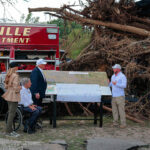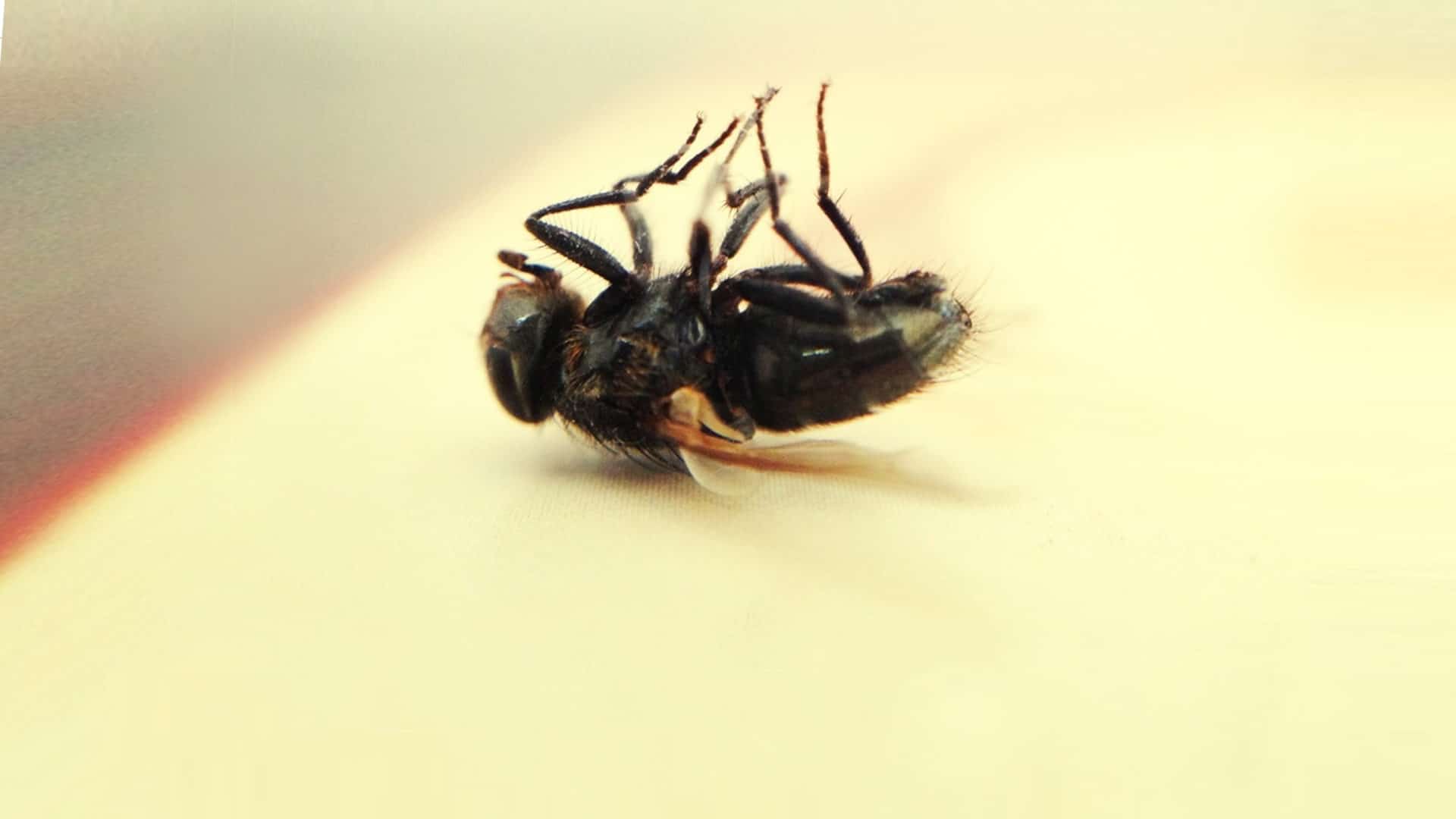When I was growing up in Tulsa, Oklahoma, long before we spent our evenings drawn to the soft glow of electronic devices, I would sit down in my grandparents’ backyard on summer nights and watch the air twinkle with fireflies. They allowed me to catch a few in a jar, so I could study their tiny anatomy amid brief bursts of light from within. But I was always made to set the insects free to continue their light show — or, frankly, to become food for frogs, spiders, and other creatures of the night.
MATTERS OF FACT: Exploring the intersection of science & society.
Fast-forward 20 years and I was teaching science to preschoolers, indulging my nostalgia with a lesson on the Lampyridae family of beetles, commonly known as fireflies or lightning bugs.
My budding scientists learned to pronounce the word “bioluminescence” — the chemical reaction inside a firefly’s abdomen that produces light — and I had them fashion a model firefly using a soda bottle for a body, with pipe-cleaner antenna and construction-paper wings. We lit it up from the inside with a glow stick. The kids especially loved getting the “mark of a firefly” — a dab of glow-in-the-dark paint on the forehead meant to simulate the bugs’ light-emitting enzyme — and lining up in the dim park bathroom to see the radiant dots in the mirror.
What I didn’t realize until later is that fireflies were no more real to these kids than dragons or unicorns. Most, their parents told me, had never seen one. It’s now another 20 years later, and where fireflies were once abundant where I live in Central Texas, I went years without seeing them. Last year’s spring rains supposedly boosted populations, but I still only caught a few flashes here and there — a couple of lonely bugs signaling, perhaps in vain, for a mate amidst the darkness.
I had this all in mind when I recently read about a review of studies published in the journal Biological Conservation charting a catastrophic decline of insect populations worldwide. I was primed to take it at face value, and apparently, other journalists were, too, with sensational headlines ricocheting around the globe. Some called it “insectageddon.” Others wrote of a looming “insect apocalypse.” The Guardian, one of the first news outlets to cover the story, declared that “plummeting insect numbers threaten ‘collapse of nature.’”
Meanwhile, entomologists and ecologists around the world took to Twitter, blog posts, and editorials to point out serious methodological flaws in the research, and to refute the study’s doomsday findings. Among these was Atte Komonen, a senior lecturer in the department of biological and environmental science at the University of Jyväskylä in Finland. In a response published in the journal Rethinking Ecology, Komonen and colleagues worried that the unsubstantiated claims pinballing across the globe could diminish public faith in science, and even undermine efforts to address the real stressors that many of the planet’s insects face.
“The problem is real, insects are declining in many regions,” Komonen told me. But, he added, insects are not going to vanish globally in 40 years. “It’s dramatic, over-exaggerated, and it reduces the credibility of … conservation science — or any other science for that matter.”
Indeed, according to Manu Saunders, an ecologist at the University of New England in Australia, the flawed review and poorly considered media hype gave the false impression that we have a handle on the state of the world’s insect populations when, in fact, we really don’t. “Widespread, consistent insect declines are a real concern,” Saunders noted in a critical analysis published in the May/June issue of American Scientist. “Yet there is little published evidence that worldwide decline of all insects is happening.”
Journalists ignore these nuances at the peril of everyone, she and other experts told me. That’s because when the real picture eventually emerges — a picture inevitably filled with boring things like caveats, counter-evidence, and a good deal of lingering uncertainty — the public’s understanding of science, along with their faith in its practitioners, will have once again been undercut.
The first wave of Insectageddon stories hit in late 2017 after publication of a study suggesting a 70 percent reduction in flying insect biomass — the total volume of such insects — over 27 years at nature reserves in Germany. The next round came a year later in response to a study that discovered a precipitous drop in insects the Luquillo rainforest in Puerto Rico between 1976 and 2012, accompanied by reductions in the populations of the lizards, frogs, and birds that feed on them.
That was followed by the Biological Conservation review published earlier this year, in which two Australian researchers — Francisco Sánchez-Bayo, a research associate in the school of life and environmental sciences at the University of Sydney, and Kris Wyckhuys a professor of biology at the University of Queensland — analyzed data drawn from the Germany and Puerto Rico studies, along with 71 other studies of insect decline.
“As each study came out, the surrounding hype grew,” Saunders wrote, “filling broadcast and online platforms for popular-science news with a heady mix of hyperbole, anecdote, and speculation.”
With its global scope and unusually dramatic language, the Sánchez-Bayo and Wyckhuys review was a natural catalyst for sensationalist headlines. Based on their analysis, the authors characterized the state of insect biodiversity in the world as “dreadful.” “Almost half of the species are rapidly declining,” they wrote, “and a third are threatened with extinction.” The main driver of the decline, according to the researchers, is loss of habitat to intensive agriculture and urbanization. Other contributors include pollution from sources such as pesticides, fertilizers, and industrial chemicals; biological threats from pathogens and invasive species; and climate change.
They concluded that unless humanity changes its ways, “insects as a whole will go down the path of extinction in a few decades.”

Lead author Sánchez-Bayo said he and his co-author were concerned that scientists who reviewed the study prior to publication would ask them to tone it down. But they didn’t. “That means to us that they agreed with us,” he said. To him, the impending collapse of insect life and the ecosystems they support warrants all the drama he can muster, so that both researchers and the public sit up and take notice. “[We need to] make them realize that it is a problem and we’ve got to handle it.”
And yet, experts I talked to expressed surprise that the study passed peer review. Many of the earlier studies examined in the Sánchez-Bayo meta-analysis were “localized and skewed toward particular taxa,” Saunders wrote in her critique. Several critics also noted that in reviewing the scientific literature, the authors deliberately sought out papers on insect declines, quite possibly overlooking research showing stable or increasing populations. (Sánchez-Bayo said that he and his colleague included other research as well, but the criteria for selection wasn’t clear.)
“The problem to me is that they are mixing really miscellaneous studies,” said Komonen. You could use that information to do a qualitative overview, he said, “but if you want to do this exact prediction of the extinction rate and what are the reasons behind [it], it’s just — you can’t do that. It’s impossible.”
The other key issue, Saunders suggested, is that the researchers based global predictions on limited data from just a few regions, predominantly Europe and parts of the U.S. She also pointed out that the review covered about 2,900 species — a tiny fraction of the estimated five million species of insects on Earth. “The most studied groups are bees, beetles, and butterflies,” she said. “For the vast majority of the rest of the species of insects in the world, there’s just no data and no one’s studied them.”
Biological Conservation later published a letter critical of the study, as well as the authors’ rebuttal to that criticism. In an email, the journal’s editor in chief Vincent Devictor credited the study with initiating a “very useful debate.” But, he wrote, “the merits of the study were unfortunately overshadowed by the critics (most of them justified).”
Chris Thomas, a highly regarded expert on biodiversity loss and species decline at the University of York in the U.K. and one of authors of a critique of the Sánchez-Bayo and Wyckhuys meta-analysis, was unequivocal in his assessment: “It is a dreadful piece of science,” he told me. “It’s really bad.”
The journal itself was also negligent, he added, for having published the paper in the first place.
But Thomas also laid blame on the press. “I’m pretty cross with journalists,” he said. “I mean, not in an angry sense. But I mean in a dissatisfied sense with journalists who either didn’t inquire more, or did inquire but went with this more exciting-sounding story anyway. And I just don’t think it’s in people’s — in our long-term interests for the rational interaction of humanity with the planet — to behave in that way.” (He did not name names.)
Of course, some journalists reported the story with more nuance — though some did so sooner than others. Within a week or so of the latest Insectageddon flare-up, the science writer Ed Yong published a well-balanced account in the Atlantic. After reading that, Brian Resnick, a science reporter with Vox, did additional research on the study’s shaky methodology and updated his previously published story, noting the changes at the top of the article. “Corrections and changing things can feel scary,” he said. “But I always feel like as a journalist you can’t pretend you don’t know something.”
Want more Undark? Subscribe to our weekly newsletter!
But these examples were exceptions in the science press, not the rule — and that’s part of the problem, Saunders said. The story the media often misses is far more complex — and in some ways more dire — than the sensationalist fodder they frequently prefer to peddle. While the studies behind the Insectageddon story don’t provide evidence that all six-legged life on Earth is doomed, Saunders said, they do provide a window on how humans can impact biodiversity more generally.
“That humans are changing the Earth in damaging, often dangerous, ways is undeniable. Forest clearing, pesticide overuse, agricultural intensification, and fossil-fuel production have severe effects on ecosystems, including the smallest of animals,” she wrote in American Scientist. But if we hope to reverse that damage, she told me later, we need to be talking much more about the cavernous gaps in our knowledge about how all insects are responding.
That means journalists need to look beyond the hype and easy narratives to convey the messiness and uncertainty of scientific enquiry. Saunders, who trained as a journalist before returning to school to become a scientist, said she understands that sensationalism grabs people’s attention. But she also noted that by misrepresenting the science, we are gradually eroding the public’s ability to trust scientists at all.
And that has implications not just for bumblebees and lightning bugs (and yes, fireflies are on the decline, researchers think most likely due to light pollution and habitat loss), but for society’s ability to comprehend and rationally respond to a growing battery of civic debates with deep science at their core — from vaccines and GMOs to climate change and artificial intelligence.
“Science can’t be represented as absolute truth and simplified little sound bites,” Saunders told me. “That’s not what science is, and it could never be that.”
Teresa Carr is an award-winning, Texas-based journalist with a background in both science and writing, which makes her curious about how the world works. She is a former Consumer Reports editor and writer, and a 2018 Knight Science Journalism Fellow at MIT. In 2019, she began penning the Matters of Fact column for Undark.











Comments are automatically closed one year after article publication. Archived comments are below.
Interesting articlle but not enough on the details of the criticisms of the studies, nor replies to the criticisms by the studies’ authors.
But I must say that, for at least ten years or perhaps longer, anyone who drives at dusk in northern Ohio and many places like it, get to their destinations with significantly cleaner windows than in the first 40 years of my life . This articles first observation on tge decline in lightning bugs is corroborated by my own observations now for many years. There is definitely something going on in the realm of flying insects anyway.
Chemtrails
I am not against criticizing a scientific paper and its overhyping by the press – scientists should be doing that. But an article on a dispute among entomologists should make some small effort to convey the fact that entomology departments at major universities are often supported by agribusinesses and chemical companies, and that a large community of scientists may have a self-interest in limiting stories about the damage caused by, say, insecticide use and pollution runoffs. Instead, we are supposed to think that on the one side there is a scientific community dedicated entirely to truth, and on the other hand, a media community (which is not owned, itself, by corporations) that doesn’t understand and sensationalizes. Here’s a link to a listing of a few university entomology departments that seem awfully close to the agri-chemical industry: https://www.foodandwaterwatch.org/sites/default/files/Public%20Research%20Private%20Gain%20Report%20April%202012.pdf. I’m surprised that neither Martin Sorg, from the Kresfeld Entomological Group, which produced the data about the insect decline in Germany – and who cites studies of similar declines in the Netherlands – was quoted. Nor was there any mention made of what many of these German entomologists are saying: that the studies showing lesser declines often came late – were set up in the 00s – long after the intense use of pesticides and chemicals in these areas.
On the whole, until science is treated multidimensionally by journalists – with an awareness of both research and the enormous funding of research by corporate entities – we will not have good science reporting.
Are you suggesting that scientists are being paid to convey the lies of industry?
If so, you are insinuating that they are prostitutes and I demand that you give evidence of that claim.
Having a self-interest is a standard feature of any economics model of the way we function in capitalist society. According to your definition, we live in a world of prostitutes – save for the brave scientist! Congratulations on the irrationality. Now, maybe you will want to read studies showing that papers produced with funding by industries are more likely to support industry contentions than those not? Like, in my link? Like, you know, scientists do?
Or you can continue to watch your favorite cartoon, Superman Scientist: unparelleled heros who have no self interest and are saving humanity!
Also, I know its mean to reveal it to you after you’ve believed it for so long: but there is no Santa Claus.
Scientists are shills is your argument? You have lost the argument.
I am an amateur who has been trying to learn about the 20,000 or so species of bees for about four years. We have very little data on any of them because they are hard to find and study and there are not many people studying them
Most bee species spend most of the year as eggs, larvae, pupae, and pre adults, not in colonies like the much studied honey bees, but in nests of maybe 8 or 12 in the ground or in dead wood.
As an amateur, I have noticed that most metadata appears flawed for many reasons. In this case, my opinion is that it was important to get the media’s attention to the decline and not wait for studies we may never have.
If you look at US colleges and universities, most entomology courses are about the few species that are pests. Our ignorance will harm us.
Wish ticks would die.
Sorry but just the opposite is happening. The melting permafrost, milder winters, and lack of controlled burns means an increase in the tick population. Animals as large as moose and reindeer in North America and northern Asia/Europe are actually dying from being covered in ticks and subsequent blood loss. The raging forest fires around the world will actually help with the tick population but not so much with everything else.
I think the backlash is at least as damaging as the original hyperbole. The critics have made a straw man out of the original research and tied it too closely to the reporters’ breathless accounts. The researchers’ point wasn’t that all insects of every type, everywhere are inevitably doomed within years…of course they aren’t. By coming out now and implying that the authors of the German paper and other papers were deliberately exaggerating for dubious purposes, the critics (including the author of this article) are not only ruining any public understanding that may have come from the original research, but actually causing more damage by feeding the anti-science narrative. As the reporters exaggerated the original studies, they will exaggerate the critics of them, ignore their attempted nuance, and damage science all the more gravely.
For a great piece on insect declines, and the problematic nature of the data, which appeared before the late 2017 paper, see Gretchen Vogel’s May 2017 piece in Science: https://www.sciencemag.org/news/2017/05/where-have-all-insects-gone
Enjoyed the article. I agree we need to avoid knee jerk and sensationalism. I also know anecdote is not data. But I do want to share that I remember 30 years ago helping to wash my father’s car and how the front of it would be covered in a thick mass of flies and other insects. Washing my own car now, after having made many of the same journeys, there are many fewer, more than 50% less. This is in the north of Scotland. I’m fairly sure its not the aerodynamics of the cars so although I take the flawed studies with a pinch of salt, they do ring true to my experience too.
I’ve been talking about this recently. In Australia, you couldn’t drive 50 k’s without dozens of bugs and moths splatting against the windscreen. Fast forward 30 years and I recently did a 7000 km round drive to the North of this enormous country and barely had a mark on my windscreen. Anecdotal, yes, but nonetheless very real.
Great reminder for journalists not to automatically run with catchy headlines. At The Conversation US, we recently published this commentary by a PhD student who raises some of the same points: https://theconversation.com/is-an-insect-apocalypse-happening-how-would-we-know-113170.
Great article. Lots of parallels to the recent UN nonsense about mass extinctions.
“I just don’t think it’s in people’s — in our long-term interests for the rational interaction of humanity with the planet — to behave in that way.”
Which way? Emphasizing consequences of obviously unnecessary destructive commercial activity, or performing obviously unnecessary destructive commercial activity?
“Rational interaction” isn’t where we are starting, we have no long term interest today.
If you’re curious about how the world works you should recognize that no one knows how the world works and acts accordingly.